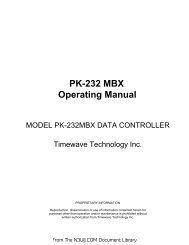TH-D72A/E - N3UJJ
TH-D72A/E - N3UJJ
TH-D72A/E - N3UJJ
You also want an ePaper? Increase the reach of your titles
YUMPU automatically turns print PDFs into web optimized ePapers that Google loves.
2 HOW YOU ENJOY APRS WI<strong>TH</strong> <strong>TH</strong>-<strong>D72A</strong>/E(WRITTEN BY BOB BRUNINGA, WB4APR)APRS OverviewThe <strong>TH</strong>-<strong>D72A</strong>/E APRS Handy Transceiver brings so many new capabilities and enhancements to theportable and mobile operator, that it is hard to fully grasp the power that this brings to APRS. Besidesthe built-in GPS, and significant enhancement of the capabilities and depth and breadth of APRS, thenew radio continues the evolution of the fundamental principles of APRS as a common informationresource channel for facilitating human-to-human communication on Amateur Radio. To see howthis fits in, it is first necessary to understand the history of APRS and packet radio.Packet Radio HistoryThe roots of the Automatic Packet Reporting System (APRS) go back to the late 1970s as theAMRAD (Amateur Radio Research and Development) Group was excitedly beginning to experimentwith AX.25 packet radio. This was before the Internet and as we spent our free time in our shacks,we were in fact all socially networked by the AMRAD voice repeater. All evening and weekends,someone was working on something or developing something new and sharing the excitement withthe others. We hung onto our handy transceivers everywhere we went like kids these days hangonto their iPads and smartphones to keep up with the excitement.Figure 2-1 The History of APRS from VIC-20 to <strong>TH</strong>-<strong>D72A</strong>/ESince only RTTY was legal in the USA, we developed a RTTY chat channel to augment our repeatercommunications. We wanted a digital channel that worked just like a voice repeater. That is, anyonewho had info transmitted it, and everyone monitoring captured it. Advancing from RTTY, AMRADdeveloped the AX.25 spec and as soon as it was legal, we were on the air as a chat group using realtimeUnconnected (UI) packet messaging. For this technical group, the only AMRAD operational eventwas communications support for the annual Old Dominion 100 mile endurance run. In the mid 1980s,the first vestige of APRS used Vic-20s and packet radio to share information on the hundreds ofrunners and horses across the hundreds or so square miles over the 24-hour event. There was nosuch thing as GPS. The system consisted of simply a packet channel where each checkpointbeaconed information and objects about arrivals and then transferred object responsibility as it wastaken over by the next checkpoint. At any instant, everyone could see on their screens, a list of theobjects reported at each station and their status. New information was beaconed at a high rate forimmediate delivery but decayed rapidly to reduce channel loading so that fresh information had prioritywith minimum collisions.4 CONTENTS <strong>TH</strong>-<strong>D72A</strong>/EFrom The <strong>N3UJJ</strong>.COM Document Library
















